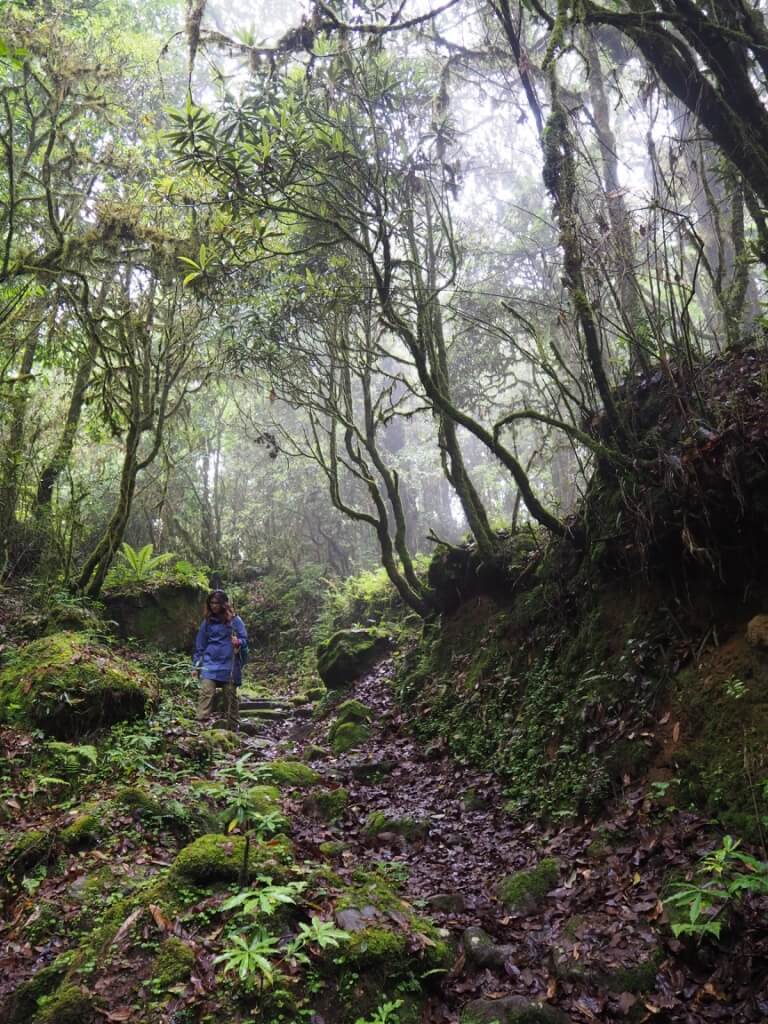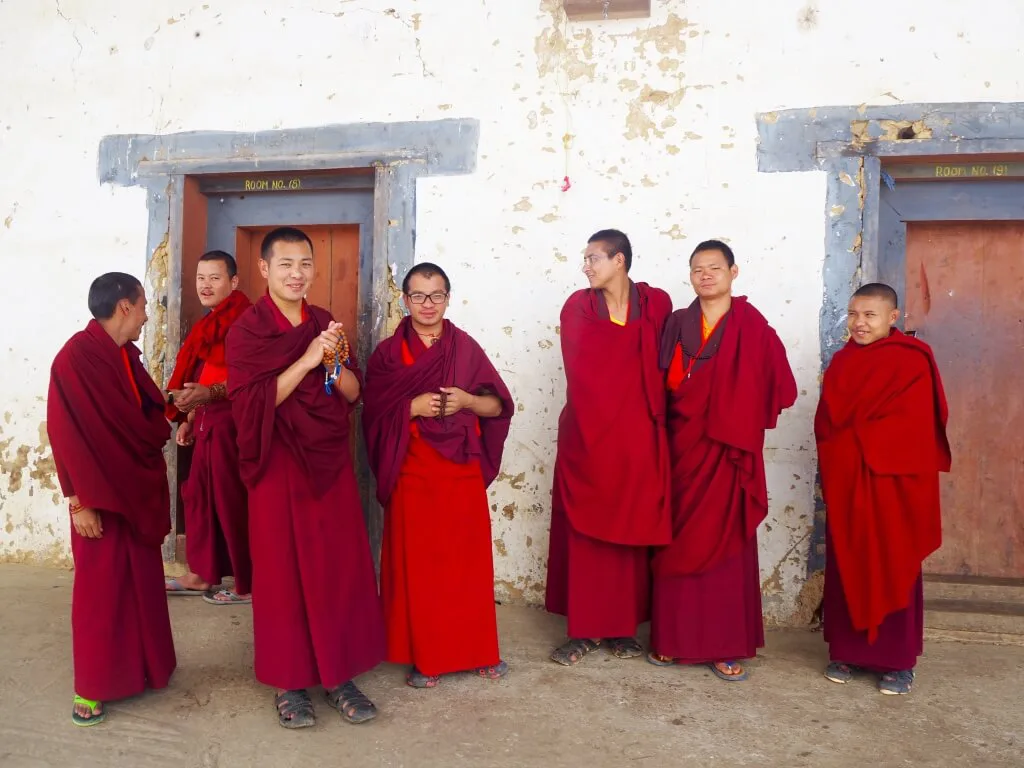In the Footsteps of the Divine Madman
Descending the 10,170 foot (3,100 m) pass of Dochu-la the towering trunks of Himalayan Hemlocks and spruce rise out of the cool misty air. Ferns, orchids and wispy strands of moss hang from the trees as we tunnel through dense stands of rhododendruns. The whole forest seems to be enveloped in cloud, creating a surreal atmosphere as birdsong echoes disorientedly through the fog.

We are following in the footsteps of Choeji Drukpa Kunley – a 14th century saint otherwise known as the Divine Madman. Originally from Tibet, Kunley is credited with helping introduce Buddhism to Bhutan and subduing a number of troublesome demons and demonesses. He is revered throughout the Himalayas and especially Bhutan where he is known for his ‘Crazy Wisdom’ using unconventional methods including shock, sarcasm, sex and outrageous acts to explain Buddha’s teachings to the masses.
Here at Dochu-la it is said that Drukpa Kunley battled a demoness that terrified this region, chasing her down this trail to a valley below where he subdued her bringing peace and enlightenment to the people. Despite the trail’s sacredness though, it had become overgrown by bushes and nearly forgotten. Last year the route was cleared and converted into a new trekking route with the help of locals and the administrative dzongkhag to revive interest in the saint’s teachings and attract pilgrims like us.


As we descend muddy paths the tree composition transitions from conifers to Asian chestnut, Himalayan yew and brown oaks. Though we are in the subtropics the trees are more reminiscent of the temperate zone. Such a huge diversity of tree and plant species are found in this forest that the entire area has been protected as Bhutan’s only Royal Botanical Park.
In this steep vertical world, plants and animals shift with altitude from one valley to the next. Because of these mountain’s myriad life zones and micro-climates many species are able to coexist and inhabit unique niches at changing elevational gradients. These forests are so diverse that Bhutan is recognized as a global biodiversity hotspot. Amongst the hotspots, the Eastern Himalayas are one of the richest for vascular plants worldwide.


As evening sets in the trail opens up to misty fields framed by a smattering of village farmhouses. An Asiatic Cuckoo sings its characteristic ‘cuckoo-cuckoo!’ high in a tree above the village as we arrive to our homestay for the evening: an ancient Bhutanese farmhouse perched above a labyrinth of terraced rice fields marching down the valley.
Soon we are gathered around a long communal sitting table and being treated to Bhutan’s famous hospitality. In no time we are warm and cozy sipping ‘naja’ milk tea, and nibbling popped rice and fresh peaches from the orchard. In this setting it’s easy to imagine wandering holy men like Drukpa Kunley being treated to similar hospitality traveling the very same pathways centuries ago.
The next morning we traverse a watery world of flooded paddies and narrow footpaths where families tend their vegetable plots and cows graze languidly in the sun. Eventually we emerge again into forest. Having descended to a lower elevation trees like ficus, magnolia and wild walnut dominate. The songs of unfamiliar bird species ring from the canopy and the drone of cicadas fills the warm air. Soon, we are introduced to another resident – leeches.
Following recent rains, the understory is alive with their small, squirmy bodies. They inch up our hiking boots, drop from tree branches and find improbable ways to nudge themselves into our socks. Even when we flick them off, a lingering sense of paranoia remains. In this damp, enclosed forest it feels like leeches are everywhere. Soon, shrieks fill the air as we quicken our pace, rushing down claustrophobic tunnels of green eager for an open meadow and fresh air.


As we collapse exhausted in a hilltop clearing a Mountain Hawk-Eagle wheels overhead. It has been a tough hike and trying morning. However, in Buddhist thought some challenge and hardship is an integral part of doing pilgrimage. I can’t help but think that without some struggle what merit is gained?
As we push on we enter yet another forest type where dry chir pines and sinewy shrubs dominate and the leeches thankfully dissipate. Fording a river swing bridge we pause at a hilltop chorten. Nestled in the valley below is a house where Drukpa Kunley was rumored to have once stayed. Today it is a shrine attended by resident monks.
Soon the valley opens to a beautiful mosaic of farms and paddy fields. Descending steep footpaths we pass tidy plots of tomatoes, string beans and bright green chilies guarded by scarecrows. In the distance we can see Chimi Lakhang crowning a hilltop, the temple that commemorates the Divine Madman and his teachings.



Breathlessly climbing the last hill to the temple we spin giant prayer wheels and enter a courtyard framed by a bodhi tree, the sacred tree the Buddha gained enlightenment under. Pilgrims from across Bhutan and the world visit the Divine Madman’s temple for blessings of fertility and protection. His teachings are represented today in the image of a phallus, a common symbol painted on houses across Bhutan meant to ward off evil.
It is said this temple sits atop the spot Drukpa Kunley subdued the demoness that once terrified this region. It makes me wonder if the ‘demoness’ subdued is perhaps a metaphor for subduing our own delusion though. In Buddhist thought the main point of pilgrimage is to subdue our minds. Living in our busy, hyper connected worlds the act of simply journeying in nature is a way to slow down and connect to the landscape, to one another, to self.


Whether literal or metaphorical, real or magical I try not to think too much and keep my heart open to it all. Like many times before in Bhutan the real and the fantastical blend and merge in a sort of magical surrealism. Inside Chimi Lakhang we pay respects and leave offerings of small bills. Child monks chant on the floor as drums, horns and Tibetan flutes wail crazily welcoming devout pilgrims into the temple of the Divine Madman.



Related Posts


